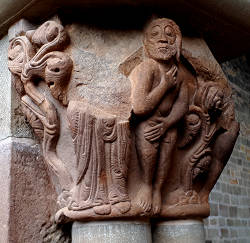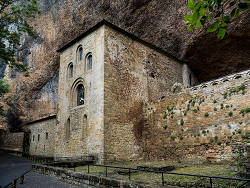San Juan de la Peña
San Chuan d’a Peña - Monesterio de Sant Chuan d’a Penya
Useful Information

| Location: | Santa Cruz de la Serós, south-west of Jaca, in the province of Huesca. (42.508, -0.6665) |
| Open: |
OCT to FEB daily 10-15:30. MAR to MAY daily 10-14, 15:30-19. JUN to 14-JUL daily 10-14, 15-20. 15-JUL AUG daily 10-20. SEP to OCT daily 10-14, 15:30-19. [2020] |
| Fee: |
Adults EUR 6, Children (6-15) EUR 5, Children (0-5) free, Reduced EUR 5. [2020] |
| Classification: |
 Cave Church Cave Church
|
| Light: |
 Incandescent Incandescent
|
| Dimension: | |
| Guided tours: | |
| Photography: | |
| Accessibility: | |
| Bibliography: | |
| Address: |
San Juan de la Peña, Tel: +34-974-355119.
E-mail: |
| As far as we know this information was accurate when it was published (see years in brackets), but may have changed since then. Please check rates and details directly with the companies in question if you need more recent info. |
|
History
| 920 | beginning of construction under the protection of the rock, lower church. |
| 11th century | Íñigo de Oña spends some time here as a monk. |
| 1026 | beginning of construction, donated by King Sancho I. |
| 1028 | Benedictine rule introduced for the monastery. |
| 22-MAR-1071 | first place in Spain where the Roman rite was introduced. |
| 1494 | a fire causes great damage. |
| 24-FEB-1675 | a fire destroys the old monastery partly, construction of new monastery started. |
| 17th century | construction of the New Monastery. |
| 16-AUG-1835 | secularized by the state. |
| 13-JUL-1889 | old monastery declared a National Monument. |
| 1923 | new monastery declared a National Monument. |
| 1999-2007 | completely renovated, a luxury hotel, a center on the history of the Kingdom of Aragon and one on the history of the monastery. |
Description


The Royal Monastery of San Juan de la Peña (Saint John of the Cliff) was one of the most important monasteries in Aragon in the Middle Ages. It was named after the overhanging cliff under which the church was erected, de la Peña translates of the cliff or of the rock. The place is a narrow gorge in the conglomerate rock of the Sierra San Juan de la Peña which was formed from the debris from the Pyrenees. This rock is rather soft, so it was rather easy to extend the cave, the two-level church is partially carved into the stone of the cliff. Quite exceptional is the fact that the cave is located on the southern wall of the gorge, opening to the north. As a result the monastery never gets direct sunlight. Obviously the early hermits took their asceticism very seriously.
The place was used by survivors of the Muslim conquest of Spain in 711. It was a loose community of hermits which existed until the 10th century. The area was conquered by Galindo Aznárez II in 920, who ordered the erection of a monastery dedicated to Saint Julian and Saint Basilisa. In the lower church some mozarabic architectural elements survived from this time, but most of the monastery including the impressive cloister under the great rock are Romanesque.
King Sancho I donated the monastery dedicated to John the Baptist. It was a time of many changes. Construction began in 1026, and in 1028 the Benedictine rule was introduced. In 1071 the Roman rite was introduced and replaced the Visigothic rite. Also the Rule of Cluny, a stricter adherence to the Rule of St. Benedict, was introduced. Unfortunately the documents from this era are often forged, as was customary at the time, and there was a violent dispute with the Bishop of Jaca around 1100. As a result exact statements about the early history of the monastery are difficult.
San Juan de la Peña was a center of science and culture in Aragon. The scriptorium of the monastery created many manuscripts. The oldest surviving Bible manuscript from Aragon, a 194-sheet copy of the Bible on parchment, was created here. King García Sánchez I of Navarre granted the monks the right to justice. The monastery gained its greatest importance and also became the burial place for the kings of Aragon. His successors to Sancho Garcés III. further promoted the monastery. Most of the preserved buildings including the cloister were built in this era.
The old monastery is still in this state, though damaged, because is burned down in 1675. What remained was left untouched, the new monastery was erected 100 m higher on the plateau of San Indalecio, which was more favorable in terms of climate and also offered a lot more space. After its secularization in 1835 it fell into disrepair and was only partially restored at the end of the 19th century. It was completely renovated between 1999 and 2007. including a luxury hotel, a center on the history of the Kingdom of Aragon and one on the history of the monastery.
According to legend the Holy Grail, the chalice of the Last Supper, was sent to the monastery for protection and prevention from being captured by the Muslim invaders of the Iberian Peninsula. It is alleged to be the same cup that was presented in 1438 by Alfonso V of Aragon to the Valencia Cathedral. The Valencia Chalice or Sant Calze is an agate cup in the Cathedral of Valencia. The artifact has never been accredited with any supernatural powers. And as we know from Indiana Jones 2: an agate cup is never the cup of a carpenter.
- See also
 Search DuckDuckGo for "San Juan de la Peña"
Search DuckDuckGo for "San Juan de la Peña" Google Earth Placemark
Google Earth Placemark Royal Monastery of San Juan de la Peña - Wikipedia (visited: 05-JUL-2020)
Royal Monastery of San Juan de la Peña - Wikipedia (visited: 05-JUL-2020) Chronicle of San Juan de la Peña - Wikipedia (visited: 05-JUL-2020)
Chronicle of San Juan de la Peña - Wikipedia (visited: 05-JUL-2020) Monastery of San Juan de la Peña, official website (visited: 05-JUL-2020)
Monastery of San Juan de la Peña, official website (visited: 05-JUL-2020) Monasterio de San Juan de la Peña, official website (visited: 05-JUL-2020)
Monasterio de San Juan de la Peña, official website (visited: 05-JUL-2020) 6 Stops on the Hunt for the Holy Grail - Atlas Obscura (visited: 05-JUL-2020)
6 Stops on the Hunt for the Holy Grail - Atlas Obscura (visited: 05-JUL-2020)
 Index
Index Topics
Topics Hierarchical
Hierarchical Countries
Countries Maps
Maps